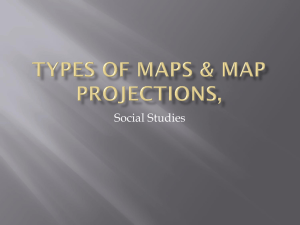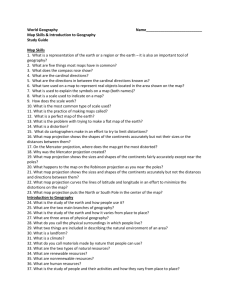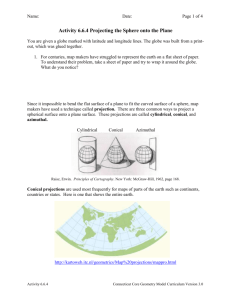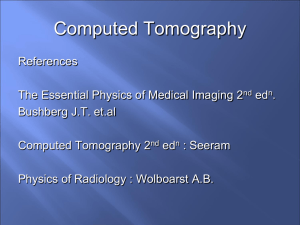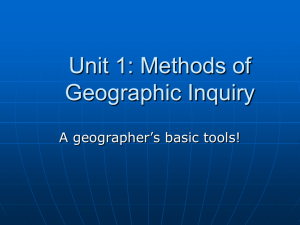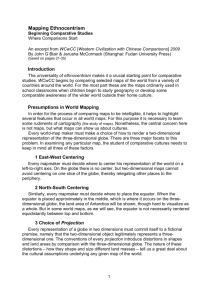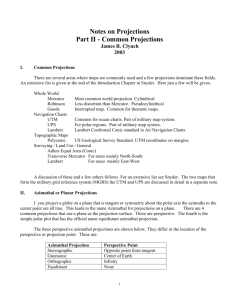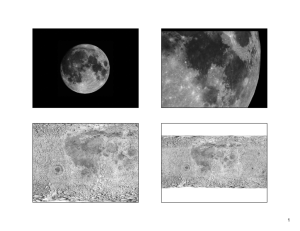Teaching Critical Thinking with Maps document
advertisement
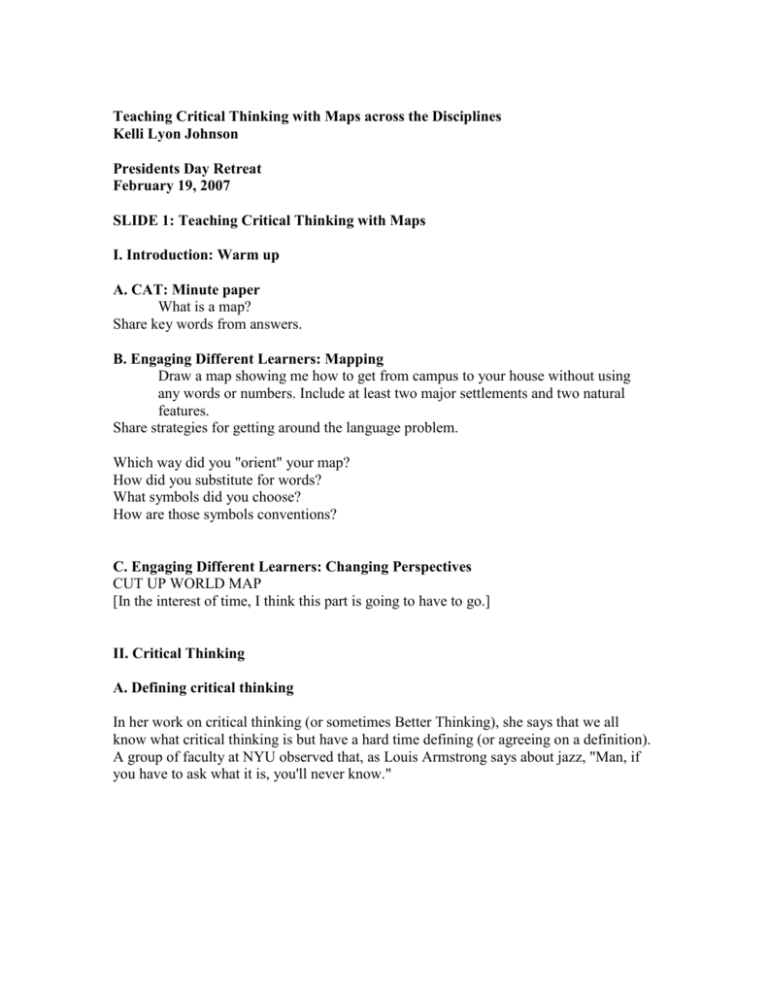
Teaching Critical Thinking with Maps across the Disciplines Kelli Lyon Johnson Presidents Day Retreat February 19, 2007 SLIDE 1: Teaching Critical Thinking with Maps I. Introduction: Warm up A. CAT: Minute paper What is a map? Share key words from answers. B. Engaging Different Learners: Mapping Draw a map showing me how to get from campus to your house without using any words or numbers. Include at least two major settlements and two natural features. Share strategies for getting around the language problem. Which way did you "orient" your map? How did you substitute for words? What symbols did you choose? How are those symbols conventions? C. Engaging Different Learners: Changing Perspectives CUT UP WORLD MAP [In the interest of time, I think this part is going to have to go.] II. Critical Thinking A. Defining critical thinking In her work on critical thinking (or sometimes Better Thinking), she says that we all know what critical thinking is but have a hard time defining (or agreeing on a definition). A group of faculty at NYU observed that, as Louis Armstrong says about jazz, "Man, if you have to ask what it is, you'll never know." SLIDE 2: Defining Critical Thinking She provides a number of definitions, and I like Penn State Faculty Senate's definition because of the specific skills they put forth, so that learning objectives are more apparent to me: Critical thinking is a term used to refer to those kinds of mental activity that are clear, precise, and purposeful. It is typically associated with solving complex real world problems, generating multiple (or creative) solutions to a problem, drawing inferences, synthesizing and integrating information, distinguishing between fact and opinion, or estimating potential outcomes, but it can also refer to the process of evaluating the quality of one's own thinking. Everyone seems to agree that it will vary by subject, so critical thinking may mean different things in your discipline. B. Teaching Critical Thinking Unfortunately, this is not how most students define critical thinking. Miami did a study of students' beliefs about critical thinking. Most students believe that being able to read and understand a critical article (secondary sources) constitutes critical thinking. (These were graduating seniors.) Research in the assessment of critical thinking has demonstrated that students need to be taught critical thinking. SLIDE 3: Assessing Critical Thinking In my own research in assessing critical thinking, I found that we need to tell them what it is and we have to show them how to do it. Assessment of Critical Thinking Substantially Developed Mostly Developed Somewhat Developed Undeveloped Paper I no rubric 3 4 5 4 5 6 4 3 4 1 2* Paper II rubric and discussion Paper III rubric, directed 10 discussion, and revised assignment * Total does not include plagiarized paper. As the table shows, I found some improvement with the use of the rubric and a general class discussion about critical thinking, but the real improvement came with the third paper. Before students completed that paper, I led a more directed discussion of critical thinking, giving both advice about and examples of the patterns and connections that often characterize critical discourse in literary and cultural study. Moreover, the design of the paper prompts led students to think critically and demonstrate their ability to think critically in the construction of their papers. My greatest achievement has been in the area of instruction and in assignment and course design. C. What We Know about Students as Critical Thinkers SLIDE 4: Performance Patterns* In her work on critical thinking, Susan Wolcott divides students into five groups with progression, or improvement, with movement from left to right: Level 0 Confused Fact-Finder Level 1 Biased Jumper Level 2 Perpetual Analyzer Level 3 Pragmatic Performer Level 4 Strategic ReVisioner Most undergraduate students are at the level of zero or one. She has found that "the majority of students exhibit Biased Jumper characteristics at the time of graduation from an undergraduate program" (3-10, my emphasis). That is, they rarely exhibit skills beyond Level One. SLIDE 5: Some Characteristics of the Confused Fact-Finder proceeds as if goal is to find the single, 'correct' answer fails to perceive uncertainties / ambiguities and complexities insists that professors, textbooks, or other experts should provide 'correct' answer appears unable to read carefully denies ambiguity (Wolcott 2-3 – 2-5) SLIDE 6: Some Characteristics of the Biased Jumper proceeds as if goal is to stack up evidence and information to support conclusion recognizes the viability of multiple perspectives but ignores contrary information equates unsupported personal opinion with other forms of evidence views experts as being opinionated or as trying to subject others to their personal beliefs often discounts or ignores alternate viewpoints (Wolcott 2-6) Her explanation: "Assignments and classroom discussions often encourage students to just state and defend their opinions, so they look only for evidence that supports their opinions" (3-10). In working with our Assessment team at Miami, Wolcott also suggested that when students work with a topic in which they have an emotional investment, they actually move backward one step or one stage. III. Maps across the Disciplines A. Conventions of Mapmaking: Truth v. Fact 1. Despite the words sometimes associated with maps—words like scientific and objective—maps are, of course, distillations of information, reductions of information And of course, maps are not always accurate. SLIDE 7: California as an island. Nicolas Sanson's 1662 "Audience de Guadalajara, Nouveau Mexique, Californie, &c." continues an already forty-year-old belief that California was an island, rather than a peninsula, which Eusebio Kino's map "Passage par terre A la Californie" disproved just after 1700. Despite the royal decree of King Ferdinand VII of Spain in 1747 outlawing its representation as an island, California continued to appear on maps that way until the latter part of the eighteenth century.7 This is how mapmaking worked in the sixteenth, seventeenth, and eighteenth century a. Maps were copied b. Mapmakers had not been to the places they were mapping. Maps thus show us the way that knowledge is constructed, invented SLIDE 8: von Humboldt's mismappings of Mexico City C. CONVENTION 1: PROJECTION SLIDE 9: Mercator projection is a cylindrical map projection presented by the German geographer and cartographer Gerardus Mercator, in 1569 Like in all cylindric projections, parallels and meridians are straight and perpendicular to each other. But the unavoidable east-west stretching away from the equator is here accompanied by a corresponding north-south stretching Like all map projections, attempting to fit a curved surface onto a flat sheet, the shape of the map is a distortion of the true layout of the Earth's surface. The Mercator projection exaggerates the size and distorts the shape of areas far from the equator. For example, Greenland is presented as being roughly as large as Africa, when in fact Africa's area is approximately 13 times that of Greenland as shown by Tissot's Indicatrix. As with any other map projection, scale varies from place to place, distorting the shapes of geographical objects. The two properties, conformality and straight rhumb lines, makes this projection uniquely suited to marine navigation: courses and bearings are measured using windroses or protractors, and the corresponding directions are easily transferred from point to point, on the map, with the help of a parallel ruler or a pair of navigational squares. SLIDE 10: Peters Projection The equal-area Gall-Peters projection has also been proposed as an alternative to address these concerns. This presents a very different view of the world: the shape, rather than the size of areas is distorted. Areas near the equator are stretched vertically; areas far from the equator are squashed. A 1989 resolution by seven North American Geographical groups decried the use of all rectangular coordinate world maps, including the Gall-Peters projection SLIDE 11: West Wing Clip D. CONVENTION 2: ORIENTATION Positioning north at the top of the page has, over time, become conventional on maps. The primacy of this north-up orientation on most maps likely originated with the recognition of the absolute direction of Polaris, and, after 1450, the prevalence of compass use, focused northward. But not all maps are oriented in this tradition. SLIDE 12: Newberry T-O map The 1532 Mappamundi of Isidore of Seville has an east-up orientation, emerging out of the tradition of “T-in-O” maps. Numerous medieval Christian maps used this orientation to reinforce the Old Testament division of the post-flood world into three parts. The east-up orientation also allows the positioning of the Christ figure with the head “oriented” to the east. SLIDE 13: Al-Idrisi Map (1192) —oriented toward Mecca Al-Idrisi was a muslim scholar in the court of King Roger II of Sicily. SLIDE 14: Florida south up SLIDE 15: Mapa Sigüenza Aztec "cartographic history" dated to the late sixteenth or early seventeenth century and named for the man who held it in his collection, Carlos de Sigüenza y Góngora. SLIDE 16: Detail of Aztlán This map depicts the Aztec migration from their place of origin, Aztlán, to Tenochtitlán, the site of present-day Mexico City, which was founded in 1325. On the Mapa Sigüenza, time begins when the Aztecs leave Aztlán. As their migration proceeds across 400 years, the orientation of the map changes, following them from place to place in their pilgrimage to Tenochtitlán, guided by the words of their god, Huitzilopochtli. SLIDE 17: Detail of Chapultepec It is not until the Aztecs reach Chapultepec, represented by a grasshopper atop a hill glyph, that the map begins to depict accurately the physical geography of the area surrounding Lake Texcoco; SLIDE 18: Detail of Lake Texcoco the places that precede Chapultepec on the footprint-marked path represent the historical events that led to the Aztecs' arrival in the Valley of Mexico rather than to geographical locations as portrayed in the European mapping tradition. SPACE IS STORIED SPACE PLACE AND TIME (HISTORY) CANNOT BE SEPARATED E. CONVENTION 3: REPRESENTATION SLIDE 19: Cortés's Map of Tenochtitlán (1524) SLIDE 20: Codex Mendoza Map of Tenochtitlán SPACE IS SOCIAL SPACE PLACE AND TIME (HISTORY) CANNOT BE SEPARATED SLIDE 21: Lone Wolf's Map This map shows Lone Wolf's trip from Fort Berthold to Fort Buford, along the Missouri River, a trip that he took in order to steal a horse from the Dakotas. To show the way to Fort Buford, Lone Wolf uses dashes to indicate his footprints. After his theft of the horse, however, his return to Fort Buford is marked by hoof prints. The map tells a story, shows an event; it is not meant as a mere geophysical representation of the area. SLIDE 22: Auchagach's map Based on at least three different maps created by Cree informants and dated to about 1728, this map shows connected waters--both lakes and rivers--that run from Lake Superior to the "mer de l'ouest"--the western sea--which did not exist but which Europeans thought to lie on the other side of the continent, accessible by "la Fleuve de l'Ouest" or, alternately, "la Riviere de l'Ouest." In addition to the rounded lakes and aligned waterways, this map also reveals a primary focus on relationships (topography), and, probably, the emphasis of culturally significant geographical locations and features. It may be that the varying sizes of these lakes, for example, represent how many days it might take to walk between them or which were most important to these particular Crees at that time. We know that places with cultural significance were often represented larger in relation to other features A lake with cultural significance, for example, may be rendered larger than other bodies of water on the map in order to emphasize its importance. Or a creek that plays no part in the reason for the creation of a map may be omitted completely. SLIDE 23: Carte Physique des Terreins Les Plus Elévés de la Partie Occidental du Canada This 1754 map by Phillipe Buache shows a further transformation of La Verendrye's map, including the Mer de l'Ouest and the belief that, perhaps, a river may run to it. IV. Conclusion: Helping Students Move to the Next Stage A. Why maps? 1. point back to words from their minute papers 2. ENGAGING DIFFERENT LEARNING STYLES: allowing students to use multiple skills sets or ways of thinking (not just students who learn best from linear lines of text on a page) 3. CRITICAL THINKING AND EMOTIONS: students generally do not have emotional investments in maps 4. ACTIVE LEARNING: instructors can use activities that engage students in active learning, not merely reading SLIDE 24: STUDENT RESPONSES • One student reported that she enjoyed the workshop because she is a more visual learner. • It is important for students to understand that symbols have meaning and construct meaning. • By using maps, the students were more willing to discuss theory and to try to understand it. Sarah Shockey, Student Associate SLIDE 25: Comments and Questions

